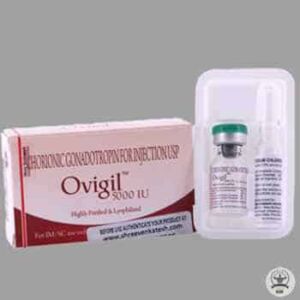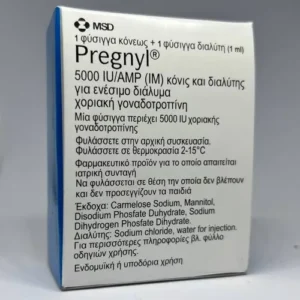
Understanding HCG and Its Role in PCT
Post-cycle therapy (PCT) is a critical period for individuals who have been using anabolic steroids. One of the key components in PCT is Human Chorionic Gonadotropin (HCG). This article delves into the importance of HCG during PCT, its usage protocols, and addresses common questions surrounding its effectiveness and necessity.
What is Chorionic Gonadotropin in a Steroid Cycle?
HCG is a hormone produced by the placenta during pregnancy. In the context of a steroid cycle, HCG is used to mimic the activity of luteinizing hormone (LH), which stimulates the production of testosterone in the testes. Anabolic steroid users often experience suppressed natural testosterone production due to the exogenous steroids’ suppressive effects on the hypothalamic-pituitary-testicular axis (HPTA). Incorporating Gonadotropic agent helps:
- a) maintaining endogenous testosterone levels
- b) preventing testicular atrophy
- c) promoting hormonal recovery
Is HCG a Must on TRT?
Testosterone replacement therapy (TRT) was created for men with hypogonadism to restore bodies default testosterone levels. During TRT, the administration of exogenous testosterone can suppress the natural production of the hormone. Here Gonadotropic agent is an important adjunct to TRT because it stimulates the testicles to produce testosterone and other essential hormones. Thus, HCG promotes fertility and preserves testicular size by maintaining testicular function in people with hypogonadism. However, whether hormonal stimulant is a prerequisite for TRT depends on individual circumstances and should be decided by the health care provider.
Primary Goals of Using HCG in PCT
- Stimulate Testicular Functions: HCG activates the Leydig cells in the testes, promoting the production of testosterone and other steroid hormones.
- Prevent Testicular Atrophy: By maintaining endogenous testosterone production, the fertility hormone prevents the shrinkage of testicles that can occur during extended periods of anabolic steroid use.
- Jumpstart Natural Testosterone Production: Gonadotropic agent helps in restoring the body’s natural hormone levels by emulating luteinizing hormone, which is critical for testosterone synthesis.
- Prepare for Subsequent SERM Therapy: HCG usage sets the stage for Selective Estrogen Receptor Modulators (SERMs) like tamoxifen, enhancing their effectiveness in post-cycle therapy.
HCG Dosage for PCT
Determining the appropriate HCG dosage is vital for efficient recovery and minimizing potential side effects. The dosage may vary based on factors such as the duration of the steroid cycle, the types of anabolic steroids used, and individual health status.
- Low-Dose Protocol: 250 IU to 500 IU two to three times per week for 2-3 weeks.
- Medium-Dose Protocol: 1000 IU every other day for 10 days.
- High-Dose Protocol: 2000 IU every other day for 10 days.
It’s important to note that exceeding recommended doses can lead to adverse effects, such as desensitization of the Leydig cells, which can hinder natural testosterone production.
How Much HCG for PCT?
A common protocol involves a total of 5,000 to 10,000 IU of HCG administered over a 2-3 week period. For instance:
- 5,000 IU Protocol: 500 IU every other day for 20 days.
- 7,500 IU Protocol: 1,500 IU every other day for 10 days.
- 10,000 IU Protocol: 2,000 IU every other day for 10 days.
The exact amount should be tailored to individual needs and ideally determined in consultation with a healthcare provider.
How Long Does it Take to Increase Testicle Size?
HCG can begin to affect testicular size within a few weeks of administration. By stimulating endogenous testosterone production and activating the gonadotropic hormones, it promotes the restoration of testicular functions. However, the time frame can vary based on individual response, the extent of testicular atrophy, and the duration of prior steroid use.
How Many Units of HCG Should I Take for TRT?
For those on TRT, a common HCG dosage is between 250 IU to 500 IU administered two to three times per week. This helps maintain natural testosterone production and supports fertility. The exact dosage should be personalized based on individual needs, and it’s advisable to consult a healthcare professional for precise guidance.
The Fertility Hormone for PCT Protocol
An effective compound protocol during PCT typically includes the following steps:
- Initiation: Start HCG administration immediately after the last anabolic steroid dose or when exogenous testosterone levels begin to decline.
- Dosage Frequency: Inject peptide hormone every other day or as advised, following the chosen dosage protocol.
- Duration: Continue therapy for 2-3 weeks to stimulate natural hormone production adequately.
- Transition to SERMs: Begin SERM therapy (e.g., tamoxifen or clomiphene citrate) 3-4 days after the last HCG injection to further promote hormonal recovery.
- Monitoring: Regularly assess hormone levels and watch for potential side effects to adjust the protocol as needed.
How to Mix HCG
Proper preparation of luteinizing hormone mimic is crucial for its effectiveness:
- Gather Supplies: You will need the peptide powder vial, bacteriostatic water, sterile syringes, and alcohol swabs.
- Sterilization: Clean the tops of both the peptide vial and bacteriostatic water vial with alcohol swabs.
- Reconstitution: Use a sterile syringe to draw the recommended amount of bacteriostatic water.
- Mixing: Inject the bacteriostatic water slowly into the peptide vial, allowing it to run down the side of the vial to avoid frothing.
- Dissolving: Gently swirl the vial until the peptide powder is fully dissolved. Do not shake vigorously.
- Storage: Store the reconstituted peptide in a refrigerator between uses, ensuring it remains effective for the duration of your protocol.
How to Take HCG for PCT
HCG is administered via subcutaneous injection:
- Dosage Calculation: Determine the correct dosage based on your protocol.
- Prepare the Injection: Draw the calculated dose into an insulin syringe.
- Select Injection Site: Common sites include the abdomen, thigh, or upper arm.
- Cleanse the Area: Wipe the injection site with an alcohol swab to prevent infection.
- Injection Technique: Pinch the skin fold and insert the needle at a 45-degree angle.
- Administration: Inject the HCG slowly and steadily.
- Post-Injection Care: Withdraw the needle, apply gentle pressure with a swab, and dispose of the syringe properly.
How to Use HCG for PCT
Effective use of HCG involves adherence to the protocol and monitoring:
- Consistency: Stick to the injection schedule without missing doses.
- Monitoring: Keep track of any side effects or changes in well-being.
- Complementary Practices: Maintain a healthy diet, adequate sleep, and avoid stress to support recovery.
- Transitioning: Move seamlessly from HCG to SERM therapy to optimize hormonal recovery.
Potential Side Effects of HCG
While HCG is beneficial, it may have side effects:
- Estrogenic Effects: Increased estrogen levels can lead to gynecomastia or water retention.
- Suppression of Natural Hormone Production: Excessive Human Chorionic Gonadotropin can desensitize the testes to LH.
- Mood Changes: Some users report depression or irritability.
- Physical Symptoms: Headaches, fatigue, or injection site reactions.
Monitoring and adjusting the dosage can mitigate these adverse effects.
Is 5000 IU of HCG Enough for PCT?
For many users, a total of 5,000 IU may suffice, especially after shorter or less intense steroid cycles. This dosage helps stimulate natural testosterone production and supports efficient recovery. However, individuals coming off longer cycles may require higher total doses, up to 10,000 IU, to achieve the desired effect. Personalization of the protocol is key, and professional medical advice can ensure optimal outcomes.
Where to Inject HCG for PCT
Common subcutaneous injection sites include:
- Abdomen: At least two inches away from the navel.
- Thighs: The outer area, midway between the knee and hip.
- Upper Arms: The back portion where there’s sufficient fatty tissue.
Rotating injection sites helps prevent skin irritation and ensures better absorption of the hormone.
Is HCG Good for PCT?
HCG is considered beneficial for PCT due to its ability to:
- Stimulate Endogenous Testosterone Production: Reactivating natural hormone synthesis is crucial after exogenous steroid use.
- Prevent Muscle Loss: Maintaining testosterone levels helps preserve lean muscle gains achieved during the steroid cycle.
- Enhance Mood and Sexual Function: Normalizing hormone levels can improve sex drive and reduce depression symptoms.
- Support Testicular Health: Prevents long-term negative effects on testicular size and function.
Is HCG Necessary for PCT?
While HCG offers significant benefits, its necessity varies:
- Necessary When:
-
- The steroid cycle was extended or involved high doses.
- There are signs of significant testicular atrophy.
- Previous cycles resulted in slow hormonal recovery.
- May Not Be Necessary When:
-
- The steroid cycle was short and mild.
- The individual has robust natural testosterone production.
- There are contraindications due to existing health conditions.
Do You Need HCG for PCT?
The decision to include HCG in PCT should be based on:
- Individual Health Status: Underlying health conditions may influence its suitability.
- Cycle Characteristics: Longer and heavier cycles suppress natural hormone production more significantly.
- Recovery Goals: Those aiming for rapid hormonal recovery may benefit more from this hormone.
- Professional Guidance: Consulting with a healthcare provider can provide personalized advice.
Additional Considerations
- Anabolic Steroid Users: Should be aware of the suppressive effects of steroids on natural hormone production.
- Endogenous Testosterone Production: Restoring this is crucial for maintaining muscle mass and sexual function.
- Selective Estrogen Receptor Modulators (SERMs): Medications like tamoxifen play a role in PCT by blocking estrogen receptors, aiding in hormonal balance.
- Adverse Health Effects: Prolonged steroid use without proper PCT can lead to hypogonadism, depression, and other negative effects.
- Hormonal Recovery: Efficient recovery ensures the preservation of lean muscle gains and overall well-being.
Conclusion
HCG serves as a valuable component in post-cycle therapy, aiding in the recovery of natural testosterone levels and testicular functions. Its role in stimulating endogenous hormone production makes it beneficial for anabolic steroid users seeking efficient recovery. While endogenous testosterone booster is not universally necessary for everyone, understanding its functions, proper usage, and potential side effects allows individuals to make informed decisions.
Incorporating HCG into PCT protocols can prevent adverse effects associated with suppressed natural hormone levels, such as hypogonadism and depression symptoms. However, it’s essential to tailor the protocol to individual needs, considering factors like the steroid cycle’s length, the types of anabolic steroids used, and personal health status.
Final Thoughts
Effective post-cycle therapy is crucial for maintaining the gains achieved during a steroid cycle and ensuring long-term health. HCG plays a significant role in this process by promoting the recovery of natural testosterone production and preventing negative effects on testicular size and function.
Always prioritize health and safety by consulting with healthcare professionals before beginning any PCT regimen. Personalized medical advice ensures that the chosen protocol aligns with individual health needs and recovery goals.

